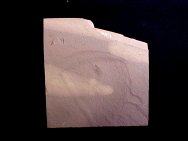|
 The
study of Precambrian and Cambrian soft-bodied fossils presents a
key problem - how can we ever be confident of interpretations based
on what are often little more than smudges in a rock? It is likely
that postulate The
study of Precambrian and Cambrian soft-bodied fossils presents a
key problem - how can we ever be confident of interpretations based
on what are often little more than smudges in a rock? It is likely
that postulate s
and conjectures will persist, but perhaps it is their persistence
and continued mystery that endows Cambrian fossils with their allure. s
and conjectures will persist, but perhaps it is their persistence
and continued mystery that endows Cambrian fossils with their allure.
Paleontologists
who examined this specific fossil believe there is about a 50/50
chance this it is a chordate. But there is also a chance that it
is a worm. This specimen has some similarities to a Nectocaris,
an extremely rare animal of unassigned phylum found in the Burgess
Shale. The description of Nectocaris is based on a single specimen
and thoughts as to its affinity vary widely from hemichordate, chordate,
arthropod, or less likely a crustacean, or possibly something completely
different. It is postulated to have been a free swimming animal
with no hard parts; a pair of short straight appendages on the front
of the head appear to be unjointed.
Chordate
origins are not fully understood though there are several theories.
Burgess Shale has a small little organism called Pikaia that has
all the ancestral chordate characteristics. The Chordates are distinguished
most notably by a notochord , a semi-flexible rod running along
the length of the animal. All chordates have a notochord at some
stage in their lives, but in some the notochord is lost in the adult,
whereas in others such as the vertebrates, the notochord is present
in the embryo but is later largely replaced and surrounded by the
vertebra, or backbone.
The
primitive Chordates remain enigmatic. Emmonaspis cambrensis, from
the Lower Cambrian of Vermont, has been variously associated with
graptolites, chordates, arthropods, and frond-like organisms since
they were first described more than 100 years ago. The most widely
accepted earliest chordate, Pikaia gracilens, from the Middle Cambrian
Burgess Shale, was originally interpreted as a polychaete annelid
(Walcott, 1911). A number of Chordates are described from the Lower
Cambrian Chengjiang lagerstätte of China.
Some references:
- Chen, J-Y.,
et. al. 1995. A possible Early Cambrian chordate. Nature, 377:720-722.
- Chen, J-Y.,
et. al. An Early Cambrian craniate-like chordate. Nature, 402:518-522.
- Conway Morris,
S. 1993. Ediacaran-like fossils in the Cambrian Burgess Shale-type
faunas of North America. Palaeontology, 36:593-635.
- Shu, D-G.,
et. al. 1996. Reinterpretation of Yunnanozoon as the earliest
known hemichordate. Nature, 380:428-430.
- Conway Morris,
et. al. 1996. A Pikaia-like chordate from the Lower Cambrian of
China. Nature, 384:157-158.
|

 s
and conjectures will persist, but perhaps it is their persistence
and continued mystery that endows Cambrian fossils with their allure.
s
and conjectures will persist, but perhaps it is their persistence
and continued mystery that endows Cambrian fossils with their allure.